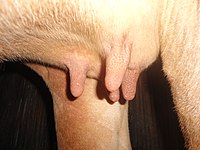
Photo from wikipedia
The main objective of the study was to evaluate whether or not implementing selective dry cow therapy (SDCT) on commercial dairy farms reduces antimicrobial consumption without negatively affecting future performances… Click to show full abstract
The main objective of the study was to evaluate whether or not implementing selective dry cow therapy (SDCT) on commercial dairy farms reduces antimicrobial consumption without negatively affecting future performances when compared to blanket dry cow therapy (BDCT). Twelve commercial herds in the Flemish region of Belgium with overall good udder health management were enrolled in a randomized control trial, including 466 cows that were assigned to a BDCT (n = 244) or SDCT (n = 222) group within herds. Cows in the SDCT group were dried off with internal teat sealants combined or not with long-acting antimicrobials according to a predefined algorithm based on test-day somatic cell count (SCC) data. Total antimicrobial use for udder health between drying off and 100 days in milk was significantly lower in the SDCT group (i.e., a mean of 1.06 defined the course dose) compared to the BDCT group (i.e., a mean of 1.25 defined the course dose), although with substantial variation between herds. Test-day SCC values, milk yield, and the clinical mastitis and culling hazard in the first 100 days in milk did not differ between the BDCT and SDCT groups. SCC-based and algorithm-guided SDCT is suggested to decrease the overall use of antimicrobials without jeopardizing cows’ udder health and milk yield.
Journal Title: Antibiotics
Year Published: 2023
Link to full text (if available)
Share on Social Media: Sign Up to like & get
recommendations!